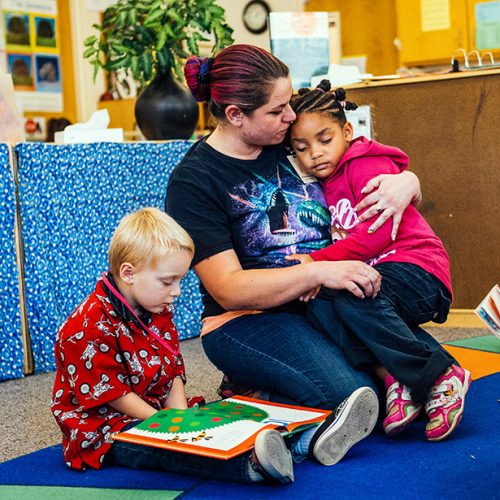
 |
| Kids read in a Head Start classroom — Head Start serves 1,120 children and their families in Lane County. Photo by Todd Cooper. |
Colton Thompson is 6 years old. He has a mop of light blonde hair and a mischievous look in his eyes. He goes to school in Springfield.
One day during school, a classmate came up to Colton with a message from Colton’s dad. Colton and his family are fleeing domestic abuse, so the message scared him. Colton’s mom has a restraining order against his dad, and his family is staying in a safe house.
Colton spent the rest of the night throwing up. He feared that his dad would take him from school. Ever since then, Colton hasn’t liked school very much.
Colton, his sister Lala and his brother Xavier are three of 491 unhoused K-12 students in the Springfield School District. Homeless children comprise 4.44 percent of students in the district. Eugene School District 4J’s percentage is slightly smaller at 4.24 percent, but in Bethel School District, 7.21 percent of students are unhoused.
Colton’s mom, Cozette Thompson, fled her abusive partner 10 months ago, and while she and her kids are now safe, “it’s affected my children tremendously,” she says. They missed three months of school while the family was on the run, an unavoidable consequence of trying to keep away from an ex hellbent on ruining Cozette Thompson’s credit by putting houses and a car under her name, which ruined her credit, she says.
Things are getting better, she says — the family lives in a safe house and she now feels comfortable going out in public — but all of her kids have a form of PTSD after years of witnessing violent and abusive behavior.
Kids from low-income and homeless families often fight to survive, and it can take a toll on learning. The number of students who qualify for free and reduced lunches in Lane County has grown over the past 13 years — Springfield rose from 43.7 percent in 2001 to 65.6 percent in 2014 — and while these numbers aren’t a direct measure of poverty, they indicate an increase in struggling families, which parallels the lack of affordable housing and increasing difficulty of supporting a family on minimum wage.
It’s no wonder that in 2012, only 51 percent of economically disadvantaged eighth graders in Oregon met grade level standards, according to a state report. The obstacles they face — lack of transportation, health issues, hunger, trauma, constantly changing living situations — make a challenge of getting to school, let alone doing well in class and focusing energies on learning.
Research by scientists at the University of Oregon’s Brain Development Lab indicates that early learning programs can boost cognition and social skills in low-income children, especially if parents also participate. The researchers work with Head Start of Lane County, a federal program that provides comprehensive services — health, nutrition, social services, education — for low-income families with preschoolers, preparing young learners for kindergarten and helping to level the socioeconomic playing field.
But these programs need support. Since it’s a federally funded program, Head Start can’t use that money to fundraise for increased services, and hundreds of children are on the wait list. In 2012, the average Head Start teacher with an associate’s degree in Oregon made $23,473, according to the Oregon Department of Education (ODE). That’s not much of an investment.
Lane County kids need a fair chance. The children of our state are slipping behind.
 |
| Head Start celebrates its 50th anniversary this year. Photo by Todd Cooper. |
Young Minds
Cozette Thompson says the concept of family, or “ohana,” to borrow from the movie Lilo & Stitch, is an important one to her and her children. When she left her partner, she says, she didn’t want her kids to think she had given up, or that she hadn’t tried hard enough.
“I try not to talk bad about him but explain that a bad choice was made,” she says. “We’re happier now. We don’t hit and cuss. We’re a family.”
They couldn’t get a puppy, like in Lilo & Stitch, but the family keeps a pet leopard gecko to represent the strength of their bond. “I tell them that no matter what, it’s here, and it’s a part of our family,” she says. “Nobody’s getting left behind.”
Strong relationships between child and parent can act as a buffer for stress, says neuroscientist Eric Pakulak at the University of Oregon. He’s a researcher at the UO’s Brain Development Lab, where Pakulak, lab director Helen Neville and others study children’s brains.
Kids in stressful situations — domestic abuse, homelessness, lack of resources — can experience physiological changes in their brains. “The brain is the central organ of stress regulation,” Pakulak explains. “The same parts of your brain that are really important for regulating and maintaining a good stress response are the same parts of your brain that are important for many aspects of learning and cognition.”
Pakulak says that when children are under constant stress, it can affect parts of the brain involved in memory, learning and emotional processing — namely, the amygdala, the hippocampus and the prefrontal cortex.
Broadly speaking, he says, stress and trauma can alter the density of neurons within parts of the brain or affect the size and function of different structures. When kids are emotionally saturated and overwhelmed, they can’t learn. That’s the bad news.
The good news is that the brain is changeable. “The earlier you can intervene, the better,” Pakulak says.
Pakulak and his colleagues have collaborated with Head Start of Lane County for 10 years to come up with a preschool program that works closely with low-income kids and parents to improve brain function, cognition and behavior.
In a 2013 study, the team observed that family-based training programs “designed to improve brain systems for selective attention” resulted in positive changes, including less parent stress, better child social skills and an increase in child cognitive ability.
“Our evidence suggests that parent involvement is pretty central,” Pakulak says.
The UO Brain Development Lab is part of a national consortium on early child education run by James Heckman, an economist at the University of Chicago. Heckman’s research indicates that investing in early childhood education pays off in the long run.
Research suggests that early childhood interventions can lead to higher graduation rates, higher college attendance rates and less crime, and Heckman quantified this return on investment as getting seven times back what was initially invested.
“The evidence is there in terms of cost effectiveness,” Pakulak says. “What we’re trying to do now is develop and assess this model of our program that we’ve shown to be successful. If we can implement this on a larger scale, we can share it with the world.”
Left Behind
Programs like the one in development at the UO are intended to bridge the gap between the advantaged and less advantaged. Inequity of opportunity between privileged and underprivileged children is nothing new, and it hasn’t changed much in recent years.
The disparity between these two demographics is known as an achievement gap, a somewhat obtuse term that gets thrown around in education circles. The term can refer to imbalances in test scores among levels of income, between ethnicities or other variables.
In Lane County, the number of students who qualify for free or reduced-price lunches has dramatically increased, mirroring a wider state trend. In 2001, 24.8 percent of 4J students qualified. That number increased to 40.4 percent in 2014. Well over half of students in Springfield School District qualified last year.
To qualify for reduced-price meals last year, a family of four would have to make $44,123 or less. According to the Oregon Center for Public Policy, a family with two adults and two children needs $65,695 a year to achieve “a basic level of economic security” in the Eugene-Springfield area.
Crystal Greene with the Oregon Department of Education says that although free and reduced numbers aren’t the same as federal poverty levels, “they are a clear indication of the increased need and the number of students from low-income families in our schools and communities.”
It’s one thing to look at the numbers on poverty, but what does it mean for a 6-year-old child?
It can mean she doesn’t have a ride to school because her mom just moved out of a shelter and into an apartment, and her transportation hasn’t been arranged yet. Sometimes it means that she can’t study because the other two families she lives with are making noise.
Maybe the lights are on in the other room and he isn’t getting enough sleep at night, or he can’t concentrate in school because he has a toothache and his family can’t afford to pay for a filling.
All these obstacles start to add up as children lose more academic ground.
“I have families that are in shelters dealing with domestic violence, and the kids are wondering, ‘Am I going to be able to participate in sports while I’m here? Is our taxi going to show up on time?’” explains Janet Beckman, who works with homeless families as the McKinney-Vento liaison for the Springfield School District. The McKinney-Vento Homeless Assistance Act, established in 1987, is a federal law that requires each school district to assure homeless children have equal access to public education.
“These kids have quite a lot on their minds,” Beckman says.
Early Learners
On a sunny fall afternoon, preschoolers at the Lane Community College Head Start center stand in a circle and sing a song about how to pay attention in class.
In his research, Pakulak works with kids from Head Start to study the impact of intervention on children from low-income families.
A little boy with a mohawk bounces to the song, mouthing along with the words. “This is how we listen. Eyes watching, ears listening.” The 4- and 5-year-olds take deep, calming breaths and sit down as instructor Jan Olguin reads The Rainbow Fish to the class.
The classroom is brightly colored, with paper mobiles hanging from the ceiling and a bubbling fish tank in the corner. Later in the day, the kids will eat fish sandwiches and salad, and then go outside to play — an important part of early childhood education.
“Just because families are poor doesn’t mean they shouldn’t have rich environments,” says Annie Soto, executive director of Head Start of Lane County. “We go into our work assuming that everyone has something that traumatized them, and we try to create a healing environment.”
Part of Head Start’s work, Soto says, is preventing trauma in the first place. Early Head Start launched in 2009 in Lane County, and the program is designed to work with children ages 0 to 3 and their families. “We work with parents and pregnant women to create understanding about child development and parenting skills. That’s where we support the community.”
Head Start serves 1,120 children and their families, and it is part of the Lane Early Learning Alliance, a consortium spearheaded by United Way of Lane County and joined by local school districts and other organizations invested in early childhood education. One of those is the Oregon Social Learning Center (OSLC), a nonprofit based in downtown Eugene.
 |
| Katherine Pears. Photo courtesy Katherine Pears. |
OSLC researcher Katherine Pears and her colleague Phil Fisher designed an early learning program called Kids in Transition to School (KITS), which happens two months before kindergarten starts and two months after, bridging the transition to learning. KITS helps preschoolers work on their early literacy and numeracy skills, but also teaches them how to sit still, pay attention and moderate behavior.
The program hosts 12 parent or caregiver workshops, covering the skills children need going into school. Pears says that in a study with foster children, kids who received KITS intervention had better early literacy skills than those who did not. She observed positive impacts four years later.
“These kids are at incredibly high risk, so to have effects over that long of a period is really exciting,” Pears says.
This year, OSLC and United Way of Lane County received a $2 million Social Innovation Fund grant from the Corporation for National and Community Service. It’s one of only eight programs selected nationally. The grant will help KITS to expand from serving around 200 children to potentially thousands of kids in Lane County by giving individual schools the resources and training they need to teach KITS themselves.
“This grant allows us to take a program shown to work and set up a framework that will last into the future and not just disappear when the federal funding isn’t there,” Pears says.
Life of Scarcity
Programs like KITS and Head Start help children deal with stress and trauma, which can interfere with a child’s ability to learn.
Cozette Thompson’s 3-year-old daughter Lala wears bright pink shoes, and her smile is effervescent. She enjoys going to the park and spending time with her family at the safe house. The sound of a siren makes her panic.
“She thinks when the police come, it’s something bad, that Mommy’s going to be hurt,” her mother explains. “Now whenever we hear one, we try to make it a fun thing and sing along, but she still gets scared.”
“Often folks who are lacking in resources are also facing some issue of trauma in their lives,” says Karla Snell of Head Start. “With all that against them, it’s amazing to me how many families do get their kids to school every single day.”
Snell became involved with Head Start when she was a young mother with two sons, ages 4 and 6. “I certainly know all about poverty or I wouldn’t have qualified for the program,” she says.
For low-income families eligible for Head Start, Snell says, the challenges can be daunting.
“When you’re living a life of scarcity and there’s not enough of what you need in terms of meeting basic needs — your housing, your food, being able to do your laundry — when those things are occupying your time and energy, it’s really hard to focus on your future,” she says. “Education, mental and physical health — those things fall to the back burner because you’re so busy meeting your immediate needs.”
Parents might have to drop kids off at daycare plus multiple schools and may have difficulties getting to work on time. It’s not because they’re bad people, Snell says. It’s the reality of their situation.
Soto says that bias against low-income families can cause judgmental behavior from those who don’t understand. “People who are considered marginalized are often judged more harshly,” she says.
“There are people who advocate for young kids, but it’s not as easy to advocate for people in poverty,” Soto adds.
Invisible Population
Deborah Dailey, McKinney-Vento homeless student coordinator for 4J, says transportation is one of the biggest barriers to making sure unhoused students don’t fall behind. Family living situations are often fluid, taking kids from friends’ homes to families’ homes, from shelters to cars.
“Keeping up with transportation is very hard,” Dailey says. “Parents are moving so often, so it’s not the first thing on their mind to call me and get a bus set up.”
By the time a parent calls her, she says, sometimes a student has already missed school. “When you show up, you have a way better chance of academic success,” Dailey says. “Absences get in the way.”
Donna Butera, McKinney-Vento coordinator for the Bethel School District, says the majority of the 407 unhoused students in Bethel are living with one or two other families in a household. Sometimes this arrangement plays out with children sleeping communally in the living room and parents sleeping in the bedrooms.
“They’re not as visible as other homeless demographics might be,” Butera says. “They’re not standing on street corners with their kids, so it’s an invisible population.”
Butera says these sorts of living situations cause stress for children, because “they are at the whim of their host, and it’s often an overcrowded situation.”
Some unhoused families live in RVs or campers, some live in motels and others in shelters.
Once families are out of housing, Butera says, it’s hard to get back in. “A lot of people I work with have incomes,” she says, “but evictions, poor credit, not being able to save enough money for first and last month’s rent — these are all barriers to getting back into housing.”
Familes are often moving between housing situations, changing school districts and neighborhoods. “It’s hard to maintain that stability in a child’s education when constantly switching schools, so we try to prevent transfers whenever possible,” Butera says.
Dailey with 4J says she’s seen the number of unhoused families increase over the past seven years. She says that’s partly because she’s worked hard to train staff how to direct families to her, but this year, she’s seen more families living out of their cars than before.
Dailey says the Eugene community needs to better understand the families she works with. The biggest help to her program, she says, is for community members to “be educated about what’s going on with our homeless and unhoused population. It goes a long way when you understand what is really happening instead of assuming or relying on hearsay. We need support, compassion and understanding.”
 |
| Head Start of Lane County has centers in Eugene, Springfield, Junction City, Cottage Grove, Creswell, Oakridge and Florence. Photo by Todd Cooper. |
Strong Families
Local researchers emphasize the importance of family-based early-learning programs that involve parents and caretakers in the education process — what’s known as a two-generation approach. Working with parents can reduce stress in parent-child relationships, and it often provides continuity from the classroom to the home environment.
This method is effective but expensive.
“It’s very resource-intensive,” neuroscientist Pakulak explains. “Parents with preschool children are especially busy, and folks in our country in low-income situations are often working multiple jobs. It can make it difficult for these folks to come in for group sessions.”
Pakulak says his research group provides incentives for parents to attend, including childcare, dinner and gift cards for school supplies. It works on a small scale, but it can be cost prohibitive to expand to a larger group.
At Head Start of Lane County, Snell says that early childhood education requires smaller teacher-to-child ratios, particularly for children under the age of 3. It can cost more to find highly qualified early education teachers who act as role models for young children.
And even now, Head Start is only serving between 45 to 60 percent of Lane County’s low-income population. Soto says that more than 300 children are on the waitlist to get into Head Start, and right now, the program doesn’t have the capacity to fill the current need.
“We’re accumulating evidence that one really cost-effective way of addressing inequality in our country is to implement high-quality, evidence-based, family-based programs with enough resources,” Pakulak says. “The work of economists suggests it’s an investment. Maybe that investment won’t pay off for a generation, but it will so pay off.”
Ohana
Cozette Thompson says Womenspace and Janet Beckman of the Springfield School District helped her family on their journey to safety, but there’s still a long way to go. She took a sabbatical from her nursing job while she and her kids made their escape, and she won’t go back to her old job because her former partner knows where she worked.
She’s working to clear her record and reestablish her identity, but it’s a lengthy process. In the meantime, she hasn’t found anyone who will rent to her in the area where her kids go to school.
“There are more hurdles than people realize with domestic violence and leaving abusive partners,” she says. “People don’t understand how hard it is. Even though I have the deposits to rent a house, people don’t care. I just feel like there has to be somebody out there who will listen to me and give me a chance. I don’t want something handed to me, and I will work for it. I will do anything to prove to anybody. But it’s dependent on people giving me the chance to do it.”
Thompson volunteers at a family services house in Springfield and takes classes at Womenspace to learn more about how she can help her kids. “I want my kids to be proud of me,” she says. “I want to make sure my kids stay in school and are happy, and that they learn and know they have a happy, healthy home. That’s what I strive for right now.”
To learn more about Head Start of Lane County, visit hsolc.org.
For more on Kids in Transition to School (KITS), see wkly.ws/0.
For information on the UO’s Brain Development Lab, check out bdl.uoregon.edu.
To learn more about Lane County’s McKinney-Vento program or to contact your district’s coordinator, visit wkly.ws/0.